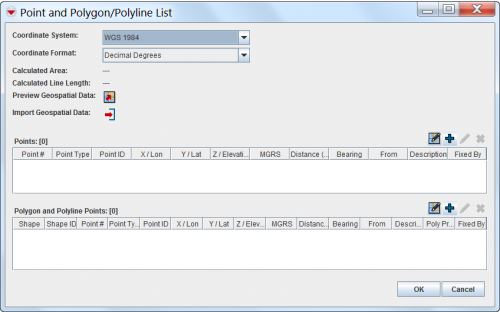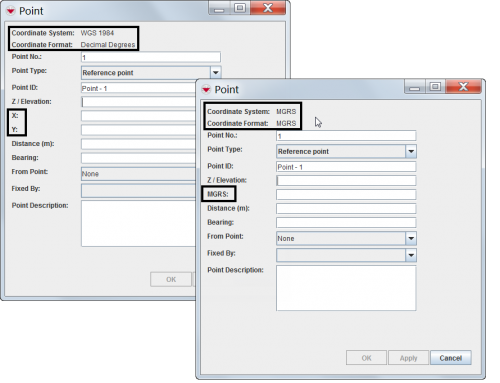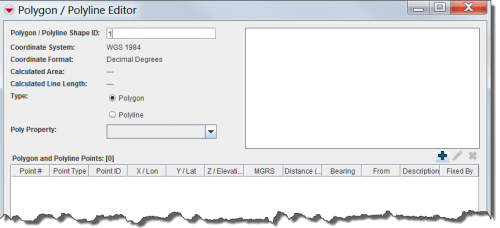Difference between revisions of "Manual Geospatial Data Entry"
From IMSMA Wiki
| Line 1: | Line 1: | ||
{{TOC right}} | {{TOC right}} | ||
==How to Manually Add coordinates for Point data ==__NOEDITSECTION__ | ==How to Manually Add coordinates for Point data ==__NOEDITSECTION__ | ||
| − | |||
To manually add geospatial data for a point: | To manually add geospatial data for a point: | ||
<ol> | <ol> | ||
| − | <li>Click the [[Image:FieldTemplateIcon.png]] button above the Points table of the Point and Polygon/Polyline List window.</li> | + | <li>Click the [[Image:FieldTemplateIcon.png]] button above the Points table of the Point and Polygon/Polyline List window. |
| − | <li>From the Point window, enter the point number in the Point No. field. Note that this is a required field. | + | |
| − | + | [[Image:PointandPolyListWindow.png|500px|center]]</li> | |
| + | <li>From the Point window, enter the point number in the Point No. field. Note that this is a required field. | ||
{{note|The fields available in the Points window will depend on the coordinate reference system that you selected.}} | {{note|The fields available in the Points window will depend on the coordinate reference system that you selected.}} | ||
| Line 13: | Line 13: | ||
<div align="center"> | <div align="center"> | ||
''Different Point Windows'' | ''Different Point Windows'' | ||
| − | </div> | + | </div></li> |
| − | |||
| − | < | ||
<li>Select the type of point that you are defining in the [[Point Types|'''Point Type''']] field.</li> | <li>Select the type of point that you are defining in the [[Point Types|'''Point Type''']] field.</li> | ||
<li>Enter the local identifier for the point in the '''Point ID''' field. Note that this is a required field.</li> | <li>Enter the local identifier for the point in the '''Point ID''' field. Note that this is a required field.</li> | ||
| Line 36: | Line 34: | ||
*To close the Point window without saving the point data, click the '''Cancel''' button. | *To close the Point window without saving the point data, click the '''Cancel''' button. | ||
</ol> | </ol> | ||
| − | |||
==How to Manually Add Polygon and Polyline Points==__NOEDITSECTION__ | ==How to Manually Add Polygon and Polyline Points==__NOEDITSECTION__ | ||
Revision as of 10:27, 16 February 2015
How to Manually Add coordinates for Point data
To manually add geospatial data for a point:
- Click the
 button above the Points table of the Point and Polygon/Polyline List window.
button above the Points table of the Point and Polygon/Polyline List window.
- From the Point window, enter the point number in the Point No. field. Note that this is a required field.

The fields available in the Points window will depend on the coordinate reference system that you selected. Different Point Windows
- Select the type of point that you are defining in the Point Type field.
- Enter the local identifier for the point in the Point ID field. Note that this is a required field.
- Do one of the following:
- To enter an absolute point, enter the coordinates in either the X/Longitude and Y/Latitude fields, or the MGRS field.
- To enter a relative point:
- Enter the distance of the point from the absolute point in the Distance field.
- Enter the bearing of the point relative to the absolute point in the Bearing field.
- Select the point from which the distance and bearing are defined from the From Point list.
- Enter a description for the point in the Point Description field.
- Do one of the following:
- To save the point and close the Point window, click the OK button.
- If you entered a relative point, the coordinates for the point are calculated based on the distance and bearing that you entered.
- To save the point and continue adding more points, click the Apply button.
- To close the Point window without saving the point data, click the Cancel button.
How to Manually Add Polygon and Polyline Points
| |
It is very important to enter points of polygons or polylines in the order they should be drawn in. |
To manually add geospatial data for a polygon or polyline:
- Click the
 button above the Polygon and Polyline Points table of the Point and Polygon/Polyline List window.
button above the Polygon and Polyline Points table of the Point and Polygon/Polyline List window. - The Polygon/Polyline Editor window displays.
- Enter the identifier for the polygon or polyline in the Polygon/Polyline Shape ID field.
- Select either the Polygon or Polyline option from the Type field.
- Click the
 button.
button. - The Point window displays.
- From the Point window, enter the point number in the Point No. field. Note that this is a required field.
- Select the type of point that you are defining in the Point Type field.
- Enter the local identifier for the point in the Point ID field. Note that this is a required field.
- Do one of the following:
- To enter an absolute point, enter the coordinates in either the X/Longitude and Y/Latitude fields, or the MGRS field.
- To enter a relative point:
- Enter the distance of the point from the absolute point in the Distance field.
- Enter the bearing of the point relative to the absolute point in the Bearing field.
- Select the point from which the distance and bearing are defined from the From Point list.
- Enter a description for the point in the Point Description field.
- Do one of the following:
- To save the point and close the Point window, click the OK button.
- If you entered a relative point, the coordinates for the point are calculated based on the distance and bearing that you entered.
- To save the point and continue adding more points, click the Apply button.
- To close the Point window without saving the point data, click the Cancel button.
| |
The fields available in the Points window will depend on the coordinate reference system that you selected. |
Different Point Windows


